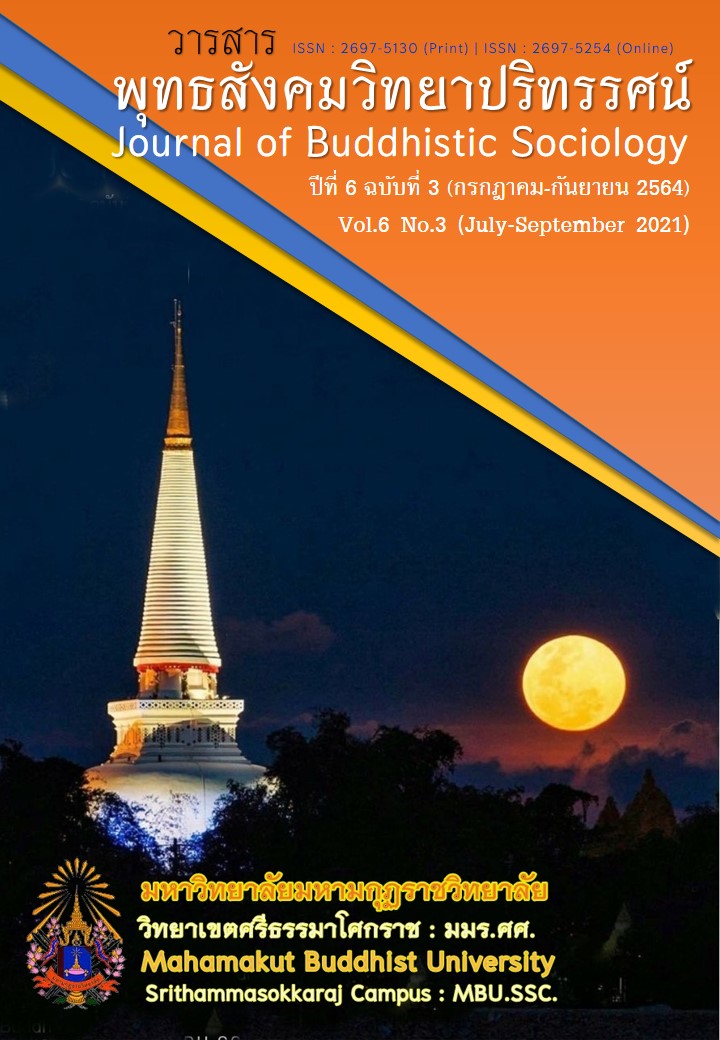THE CREATIVE LEADERSHIP OF THE SCHOOL ADMINISTRATORS IN OPPORTUNITY EXPANSION SCHOOL, KRABI PRIMARY EDUCATIONAL SERVICE AREA OFFICE
Main Article Content
Abstract
The research aimed to 1) study creative leadership, 2) compare the teachers’ opinions on creative leadership, and 3) study the guidelines to develop the creative leadership of the school administrators. The research collected the qualitative data from 8 persons using focus group discussion. The population for collecting the quantitative data was 921 people. The sample was 269 people. The research tool was a five-point rating scale questionnaire and the focus group discussion. The statistics used for data analysis included percentage, standard deviation, t-test, and content analysis.
The results showed that:
1. The overall creative leadership in all aspects was at a high level.
2. The overall result and the result of each aspect for comparing the teachers’ opinions on the creative leadership classified by gender were not different. However, there were differences in flexibility and adaptability, with the significant differences at .05. Classified by work experience, it found significant differences in the overall and all aspects, with the significant differences at .05. Classified by school size, no significant difference was found.
3. Data analysis results used for the guidelines to develop the creative leadership gained from the focus group discussion revealed that all aspects should be developed simultaneously because all aspects are vital and are the significant qualities of the administrators. The administrators must have a broad vision, various new ideas in the different processes, ability to build a good atmosphere for working as a team. They must encourage personnel in educational institutions to exchange knowledge with each other. Moreover, they must know how to assign tasks based on the knowledge and abilities of each person.
Article Details
References
กฤษพล อัมระนันท์. (2559). ภาวะผู้นำเชิงสร้างสรรค์ของผู้บริหารสถานศึกษาในอำเภอแม่วงก์ สังกัดสำนักงานเขตพื้นที่การศึกษาประถมศึกษานครสวรรค์เขต 2. ใน วิทยานิพนธ์ปริญญามหาบัณฑิตนครสวรรค์. มหาวิทยาลัยราชภัฎนครสวรรค์.
กิตติ์กาญจน์ ปฏิพัทธ์. (2555). โมเดลสมการโครงสร้างภาวะผู้นำเชิงสร้างสรรค์ของผู้บริหารสถานศึกษาอาชีวศึกษา. ใน วิทยานิพนธ์การศึกษาดุษฎีบัณฑิต. มหาวิทยาลัยขอนแก่น.
ดวงแข ขำนอก. (2559). การศึกษาภาวะผู้นำเชิงสร้างสรรค์ของผู้บริหารสถานศึกษา สังกัดสำนักงานเขตพื้นที่การศึกษาประถมศึกษานครราชสีมา เขต 6. ใน วิทยานิพนธ์ปริญญามหาบัณฑิต. มหาวิทยาลัยราชภัฏนครราชสีมา.
นัยนา ชนาฤทธิ์. (2556). ภาวะผู้นำเชิงสร้างสรรค์ของผู้บริหารสถานศึกษาสังกัดสำนักงานเขตพื้นที่การศึกษาประถมศึกษาขอนแก่นเขต 5. ใน วิทยานิพนธ์การศึกษามหาบัณฑิต. มหาวิทยาลัยมหาสารคาม.
ปราโมทย์ พูลเพิ่ม. (2560). ความคิดเห็นของครูเกี่ยวกับภาวะผู้นำเชิงสร้างสรรค์ของผู้บริหารสถานศึกษาในสำนักงานเขตบางบอน กรุงเทพมหานคร. ใน ปริญญาการศึกษามหาบัณฑิต. กรุงเทพมหานคร: มหาวิทยาลัยรามคำแหง.
วัฒนชัย เนสะและ. (2554). ภาวะผู้นำการเปลี่ยนแปลงของผู้บริหารสถานศึกษาตามทัศนะของบุคลากรโรงเรียนเอกชนสอนศาสนาอิสลามจังหวัดสตูล. ใน วิทยานิพนธ์ศึกษาศาสตรมหาบัณฑิต สาขาการบริหารและการจัดการการศึกษาอิสลาม. มหาวิทยาลัยสงขลา-นครินทร์ วิทยาเขตปัตตานี.
สำนักงานเขตพื้นที่การศึกษาประถมศึกษากระบี่. (2562). แผนพัฒนาการศึกษาขั้นพื้นฐานระยะเวลา 4 ปี. กระบี่: สำนักงานเขตพื้นที่การศึกษาประถมศึกษากระบี่.
สุภาพ ฤทธิ์บำรุง. (2556). ภาวะผู้นำเชิงสร้างสรรค์ของผู้บริหารสถานศึกษาที่ส่งผลต่อความมีประสิทธิผลของโรงเรียนสังกัดสำนักงานเขตพื้นที่การศึกษามัธยมศึกษาเขต 30. ใน วิทยานิพนธ์ศึกษาศาสตรมหาบัณฑิต. มหาวิทยาลัยขอนแก่น.
Ash, R. L. & Persall, M. (2000). The principal as chief learning officer. Developing teacher leaders. NASSP Bulletin: May.
Danner,S. E. (2008). Creative leadership in art education. In Perspectives of an Art Educater: Master of Art. Ohio: Ohio University.
Guilford, J. P. (1980). Traits of Creativity. Harmondsworth: Middiessx: Penguin Book.
Krejcie, R. V. & Morgan, D. W. (1970). Determining sample size for reseach activities. Education and Psychological Measurement (30 ed., Vol. 3).
Lussier, R. N.,& Achua, C. F. (2007). Leadership: Theory. Application, Skill development. Ohio: South-Westem College.
Stemberg, R. J. (2006). Creative Leadership: It’s a Decision. Journal of Leadership, 36(2), 22-24.


